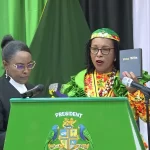Negre Mawon
Negre Mawon refers to the Maroons of Dominica, enslaved Africans who escaped to form free communities in the island’s rugged interior during the colonial period. These Maroons played a crucial role in the resistance against slavery and colonial oppression, contributing significantly to Dominica’s history and cultural heritage.
Negre Mawon Resistance and Legacy
The Maroons, also known as Neg Mawon, led numerous rebellions against the colonial forces. Key figures, such as Chief Jacko, Chief Balla, Pharcel, and Qwashi, became legendary for their leadership and bravery. They utilized Dominica’s dense forests and mountainous terrain to evade capture and launch guerrilla attacks, significantly challenging the colonial authorities.
The legacy of the Negre Mawon is commemorated through various monuments and cultural narratives in Dominica. One prominent symbol is the Neg Mawon Emancipation Monument, unveiled on August 1, 2013, at the roundabout on the corner of Turkey Lane and Victoria Street, near Castle Street. This bronze statue, created by Franklyn Zamore, depicts a muscular, shirtless man breaking free from chains, symbolizing freedom and resilience. It honours the Maroons who fought for emancipation and the enslaved Africans who suffered and resisted oppression.
Cultural and Social Impact
The Negre Mawon’s influence extends beyond their historical resistance. Their contributions to the cultural fabric of Dominica are profound, particularly in areas such as music, language, cuisine, and traditional practices. The Neg Mawon Emancipation Monument serves as a historical marker and a cultural touchstone that reminds Dominicans of their rich heritage and the enduring spirit of their ancestors.
Negre Mawon embodies the spirit of resistance and resilience in Dominica’s history. Their legacy is celebrated through monuments, cultural practices, and the continued recognition of their impact on the island’s development and identity.




